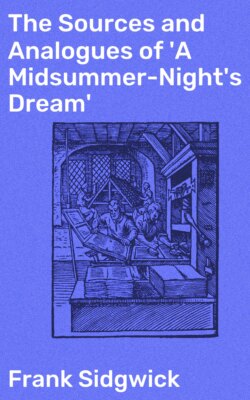Читать книгу The Sources and Analogues of 'A Midsummer-Night's Dream' - Sidgwick Frank - Страница 7
На сайте Литреса книга снята с продажи.
Оглавление2. The Grotesque Plot: Bottom and the Ass's Head: With the Interlude of Pyramus and Thisbe
Table of Contents
"But, for I am a man noght textuel,I wol noght telle of textes never a del;I wol go to my tale."—Chaucer.
The second portion of our study will not detain us long, as there are no literary sources for the "rude mechanicals," and their interlude of Pyramus and Thisbe is derived from a well-known classical story. Shakespeare draws them from life, and from his own observation of Warwickshire rustics, as he drew the two Gobbos, Launce, Christopher Sly, and a host of minor characters. Doubtless he had met many of the crew of patches, perhaps beneath the roof of "Marian Hacket, the fat ale-wife of Wincot," where we may suppose him to have made merry with "Stephen Sly, and old John Naps of Greece, and Peter Turf, and Henry Pimpernell."
Bottom takes his name from the wooden reel or spool on which thread is wound; "bottom" simply meaning the base or foundation of the reel. The names of his comrades have no specific connection with the trades they ply; but "Starveling" is appropriate by tradition for a tailor—it takes seven tailors to make a man.
The episode of Bottom's "translation," or transformation into an ass, may have been suggested to Shakespeare by a passage in Reginald Scot's Discovery of Witchcraft (1584)—a book with which he must have been acquainted, as we shall see in discussing the fairy-section of the play. Scot mentions the supposed power of witches to change men into animals, and quotes (in order to discredit) some recorded instances. Chief among these is the story[1] of an English sailor abroad, who got into the power of a witch and was transformed by her into an ass, so that when he attempted to rejoin his crew, he was beaten from the gangway with contempt. This will be found in the third chapter of Scot's fifth book: Of a man turned into an asse, and returned againe into a man by one of Bodin's witches: S. Augustine's opinion thereof. "Bodin" is Jean Bodin, who wrote a book de Magorum Daemonomania (1581; a French version was published in the previous year), and mentions this story (lib. 2, cap. vi.). According to Scot, Bodin takes the story "out of M. Mal. [Malleus Maleficarum], which tale was delivered to Sprenger by a knight of the Rhodes."
Scot mentions further the famous story of the Golden Ass of Apuleius[2]; a legend of the reappearance of one of the Popes, a hundred years after his death, with an ass's head; and gives a charm to put an ass's head on a man.[3]
From these instances a literary origin for Bottom's transformation seems probable but Shakespeare may himself have fallen in with a survival of the witch-superstition Almost while writing these words I receive first-hand evidence that such a tradition is not yet extinct in Welford-on-Avon, a village, four miles from Stratford, with which Shakespeare must have been perfectly familiar. The witch, as usual, was an old woman, credited with the "evil eye" and the power of causing the death of cattle and farm-stock by "overlooking" them; and the native of Welford, from whom the story was communicated to me, would be prepared to produce eye-witnesses of various transformations of the old woman into some kind of animal—transformations effected not only at Welford, but even in the centre of Stratford on market-day!
Shakespeare had probably met with the story of Pyramus and Thisbe in more than one form. Golding's translation in 1575 of the story in Ovid's Metamorphoses[4] is reprinted in this book[5]; Chaucer included the Legend of Thisbe of Babylon as the second story in the Legend of Good Women; and there appears to have been also "a boke intituled Perymus and Thesbye," for which the Stationers' Register record the granting of a license in 1562. There is, too, a poem on the subject by I. Thomson in Robinson's Handeful of Pleasant Delites (1584).
The Historia de Piramo e Tisbe was very early in print in Italy, and continued to be popular in chap-book form until the nineteenth century at least.
In his commentary on A Midsummer-Night"s Dream in the larger Temple Shakespeare, Professor Gollancz points out the existence of a Pyramus and Thisbe play, discovered by him in a manuscript at the British Museum.[6] This MS. is a Cambridge commonplace book of about 1630, containing poems attributed to Ben Jonson, Sir Walter Raleigh and others, though the greater portion of the contents appear to be topical verses and epigrams unsigned. Amongst these is "Tragaedia miserrima Pyrami & Thisbes fata enuncians. Historia ex Publio Ovidio deprompta. Authore N.R." In the margins are written corresponding passages in Latin from Ovid, whose story it follows closely.
The play is in blank verse of a poor kind with occasional rhyming couplets. After a prologue begins "Actus Primus and ultimus"; there are only five scenes in all, and the whole is quite short. The characters consist of Iphidius, father of Pyramus; Labetrus, father of Thisbe; their children, the protagonists; their respective servants, Straton and Clitipho; and Casina, "ancilla" or handmaid to Thisbe. There is also "a raging liones from ye woods." The moral of the play, as stated by Iphidius, is that
"the erraticall motions in children's actionsMust to a regular form by parents be reduc'd."
These lines, and others in the play, would gain by being "reduc'd to a regular form."
Footnotes
Table of Contents
1
See below, Scot's Discovery of Witchcraft.
2
He might have added
Lucius the Ass
, a similar tale by Lucian of Samosata.
3
See below, Scot's Discovery of Witchcraft.
4
Ovid,
Met.
iv. 55, sqq.
5
See below, The Legend of Pyramus and Thisbe.
6
Addl. MS. 15227, f. 56
b
.
